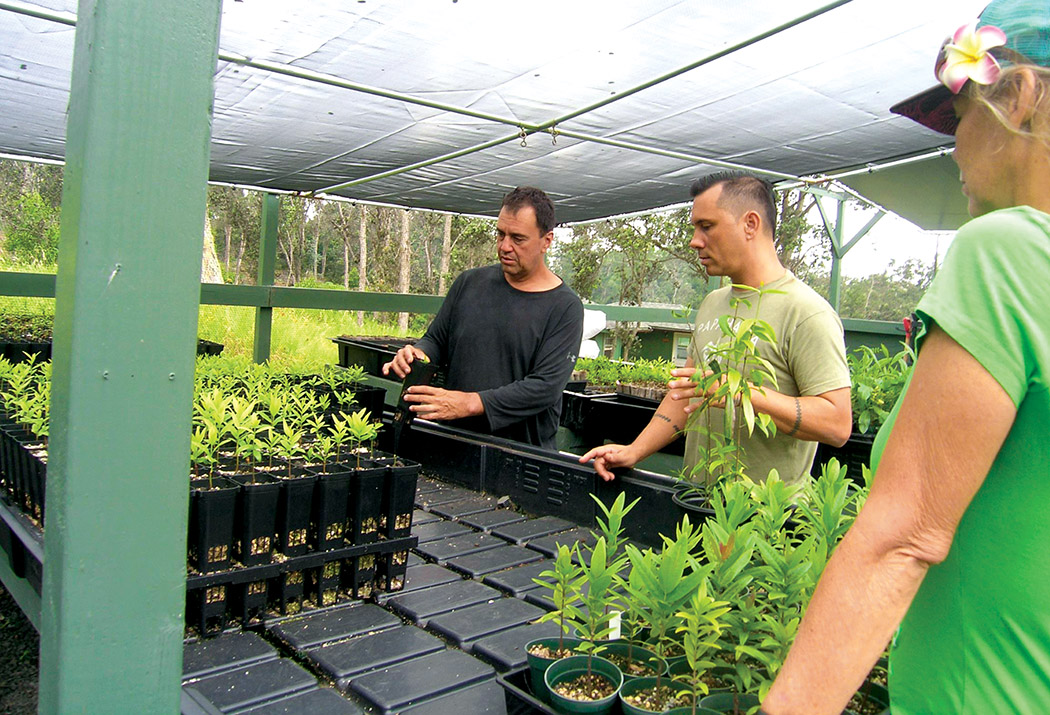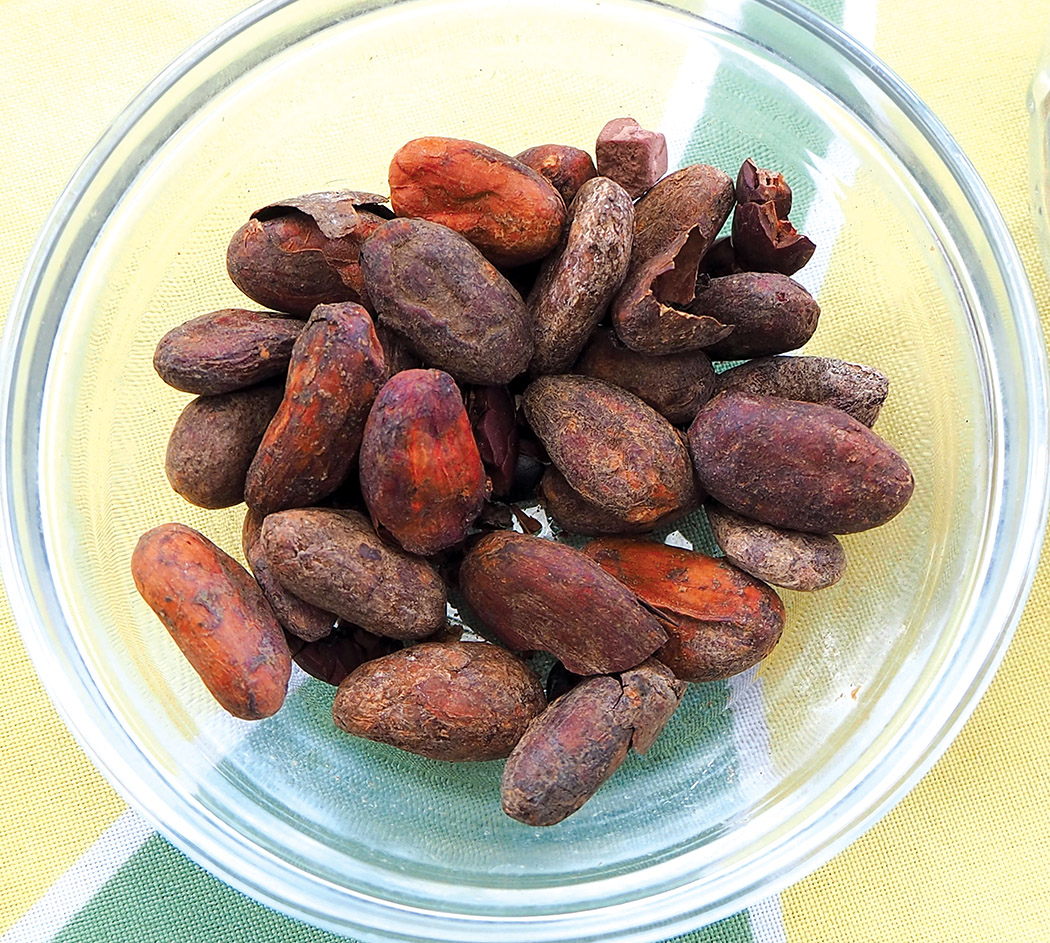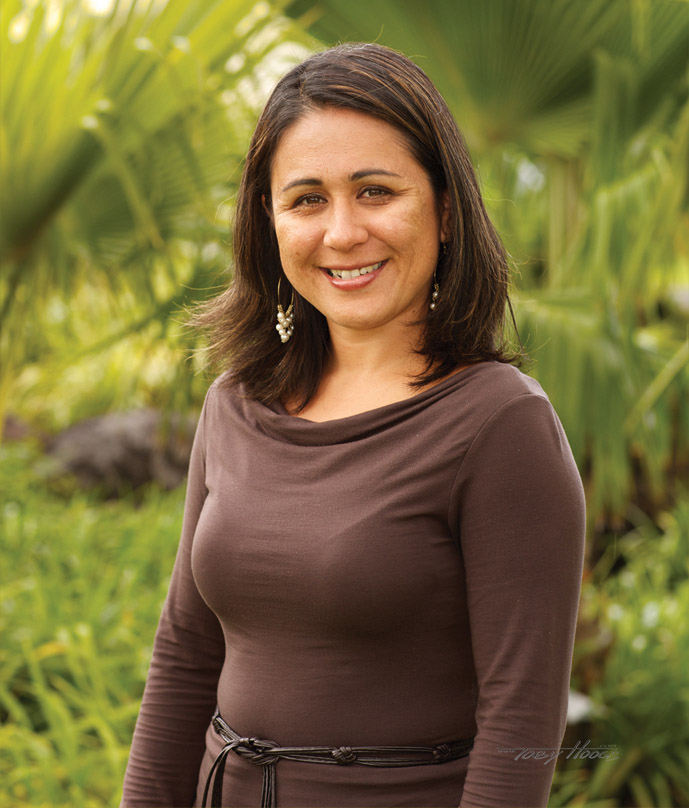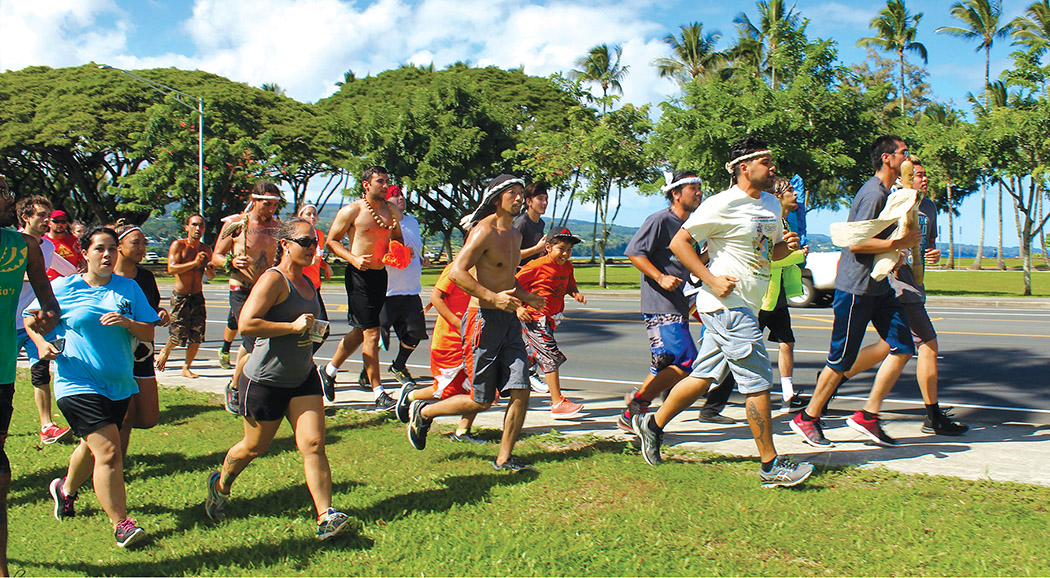
Aha Pule ‘Āina Holo, A Prayer Moving Throughout the Land
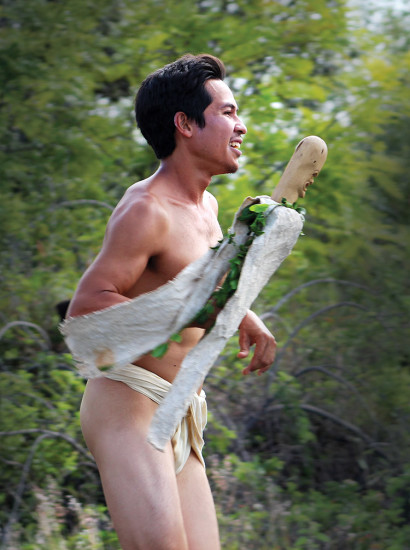
By Mālielani Larish
Embraced by bright sunshine and crisp breezes, a group of runners bearing a wooden Lono staff exit the busy Highway 19 and enter a verdant field near Anna’s Ranch in Waimea. A crowd of supporters welcome them at Manaua rain rock, where Pua Case and her ‘ohana greet them with chants honoring the hills, streams, and storied places of Waimea.
Pua knows that every joyful step of the prayer runners brings a blessing into her hometown and that many hands will hold and bless the Lono staff on the final day of its journey back to Honoka‘a.
The runners are part of the Aha Pule ‘Āina Holo, a four-day, island-encircling relay run that lives up to its name of “a prayer moving throughout the land.” The run was founded in 2014 to bring awareness to the health of the land and the people, in the spirit of Makahiki—an important Hawaiian season dedicated to honoring Lono, the god of peace, sports, and an abundant harvest. Pua Case organizes the Kohala and Waimea portions of the run and helps coordinate the event with Lanakila Mangauil, the visionary behind the run.
Rooted in Makahiki
To usher in the Makahiki season, the chiefs and kahuna carried the sacred Lonomakua staff around the island in a clockwise direction, stopping in each district to collect tribute, cleanse the land, and assess the health of the land and people. This ancient procession inspired the Aha Pule ‘Āina Holo’s route and the creation of the Lono ke kukini pule (Lono of the prayer runners) staff. Even though the modern ceremonial run draws many elements from this ancient procession, Lanakila emphasizes that the Aha Pule ‘Āina Holo is a new ceremony, not a re-creation or replacement of the ancient one.
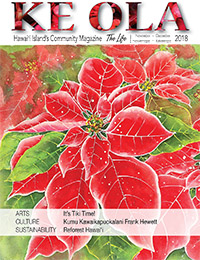
During the four months of Makahiki, no warfare or political shifts were allowed and kapu (prohibitions) were placed on work and resource extraction to encourage the revitalization of the land. With little work to perform, people moved freely throughout the land to engage in competitive sports, hula, and feasting. The Aha Pule ‘Āina Holo weaves together these themes of Makahiki through ceremony, prayer, celebration, and the physical test of running itself.
The symbolism of Makahiki also permeates the run: every footfall is a ku‘i, the pound of the ipu that stimulates and awakens the Earth. The white sweatband that the runners wear represents the clouds, and the sweat itself mimics the rain that rejuvenates the aquifers and rivers and cleanses the land. Every deep breath represents the kona (western/leeward) winds, which come during Makahiki to trim the trees and mulch the Earth. The heartbeat is akin to the pahu drums that sound during this season.
From the Piko (Navel) of the Island to the Periphery
Even before the run begins, a group of Hawaiian practitioners gather on Maunakea, conducting ceremonies at Hale o Kū Kia‘i Mauna (house of the Maunakea guardians) and the summit of the mountain before sanctifying the Lono ke kukini pule staff in Lake Waiau, officially dressing the staff. This trip to the piko of the island concludes with prayer at Pu‘u Kohe, a cinder cone in the very center of the island that overlooks Pōhakuloa Training Area.
A coordinator from each district organizes the runners from their area so the Lono staff can be handed off in relay fashion throughout the district. In addition, a core group of long-distance runners run alongside the staff each day. Every district also dictates the way in which runners and guests are greeted and cared for in the form of food, lodging, and protocol.
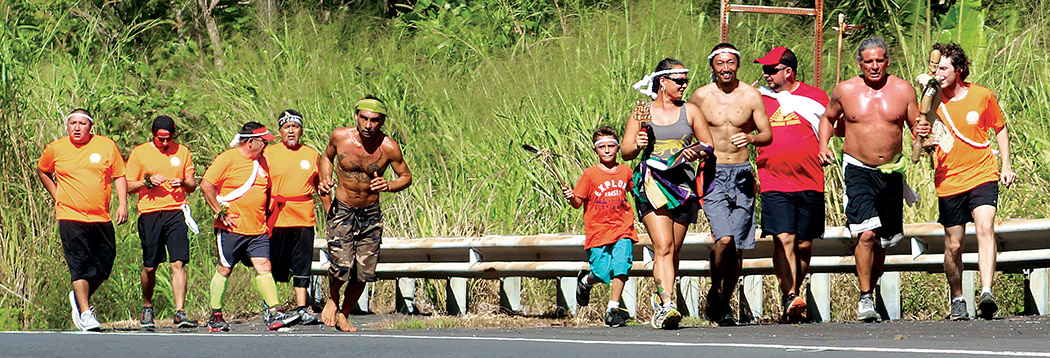
The first leg of the run traverses the Hāmākua coast from Honoka‘a to Hilo, where the Royal Order of Kamehameha I and Hilo residents conduct protocol to welcome the prayer runners at the Kamehameha statue. Hilo runners continue the run up Volcano highway, and the first day ends with prayers at Uwēkahuna Bluff (Kīlauea’s summit) and a dinner at Kīlauea Military Camp.
Every nightly celebration during the Aha Pule ‘Āina Holo brings the community together for storytelling, songs, and prayers from all faiths. “We open it up for everyone to offer their prayers,” Lanakila says.
Likewise, anyone is welcome to run alongside the staff provided they undergo a quick pi kai (ritual sprinkling of seawater or salted water for purification) beforehand given by a member of the vanguard of long-distance runners. Lanakila intends to keep the ceremony la‘a—sacred.
The next day begins with a dawn pule (prayer), and the runners set forth for Na‘alehu. Ka‘ū families greet the runners and host a lunch, welcoming the runners at Ka‘ū’s traditional Makahiki grounds. The day ends with a warm welcome at Miloli‘i’s fishing village, where another pu ‘ai (feast) is shared.

The Miloli‘i canoe club brings the Lono staff aboard for the next morning’s section of the journey. Canoes from Hōnaunau and Ho‘okena join the party and the fleet swings into Hōnaunau Bay, where protocol is conducted at Hale o Keawe. After a short paddle to Kealakekua Bay, paddlers jump out and swim the staff back to shore at Hiki‘au Heiau, the very place where Lono was said to arrive on the island every year after his annual pilgrimage to Kahiki, the ancestral homeland.
After prayers, the run traverses the rest of South Kona, heading to Ali‘i Drive, pausing at Hulihe‘e Palace and Ahu‘ena Heiau for protocol, and resting at the Old Airport for lunch. The day’s activity culminates at Pu‘ukoholā Heiau, where Kawaihae and Kohala families gather to meet the runners with hula and chanting.
Francois, a resident of Waikoloa who has run in every Aha Pule ‘Āina Holo since its inception, says, “The energy of the run is so incredible—so many people of all ages join in. We have some kūpuna (elders) running just one step, some aunties running for miles, kids, entire families, people cheering.”
On the final morning of the event, the runners traverse the coast of North Kohala and experience an enthusiastic welcome at the King Kamehameha statue in Kapa‘au. Then they snake up and over the Kohala Mountain road to Waimea, where a solid crowd of supporters gather at Manaua rain rock.
The run passes through the Hawaiian Home Lands of Kuhio Village, where lunch is hosted by ‘Aha Pūnana Leo preschool. After traveling through the town, the runners disappear down a section of Mud Lane that is impassable to vehicles and emerge at Waipi‘o lookout. The final stretch returns the Lono staff to Honoka‘a, where the People’s Theater plays host to a big, multi-cultural feast and final prayers.
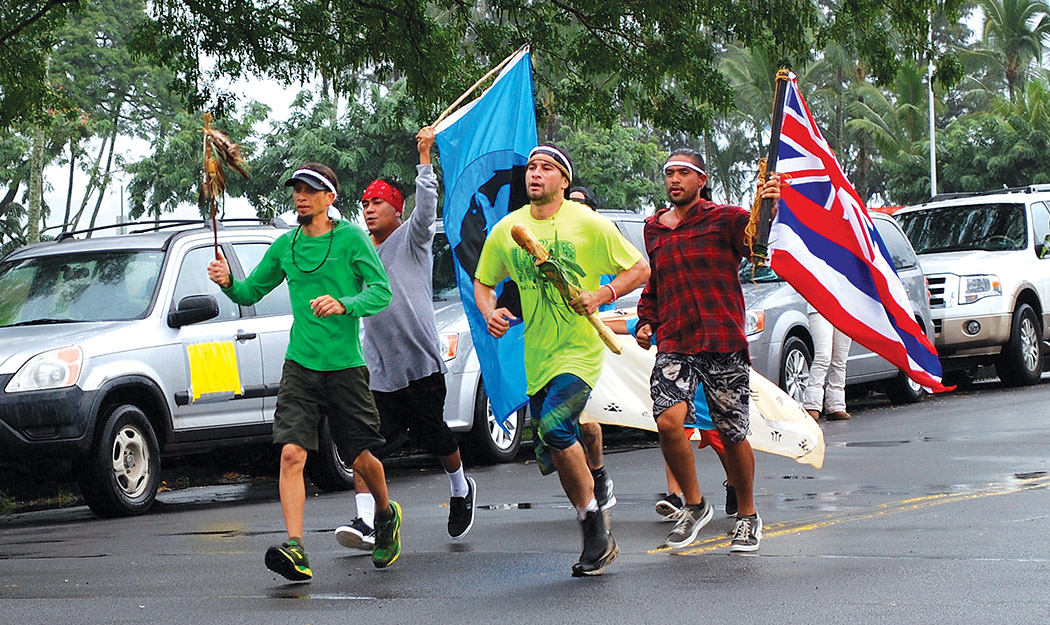
A Mutual Exchange
Every year, a mutual exchange occurs between prayer runners: runners from Hawai‘i participate in the Pit River Nation’s annual Ancestral Run in Northern California, and Pit River people participate in the Aha Pule ‘Āina Holo. Lanakila calls the Ancestral Run the “mother run” because it was his experience participating in this run that inspired him to bring this concept home. After asking Pit River Run leaders for permission to create a prayer run in Hawai‘i, Lanakila received their full blessing.
Radley Davis and other members of the Pit River community created the Ancestral Run around 1992 to re-direct everyone’s energies towards well-being and pride in a community plagued by health issues, domestic violence, and drug and alcohol abuse.
“It’s medicine that is healing for us,” Radley says. “It really is a part of us that helped us grow and get through hard times.”
Intriguingly, this mutual exchange between Hawai‘i Island and Pit River extends back to a time when knowledge was passed down orally. Pit River elders say that Hawaiians sailed to the Pit River area in canoes on a quest to visit Mt. Shasta and that they taught a hula to the Pit River people that has been passed down through the generations.
“We all inspire one another,” Radley continues. “I’m proud to be part of it, proud that it’s growing.”
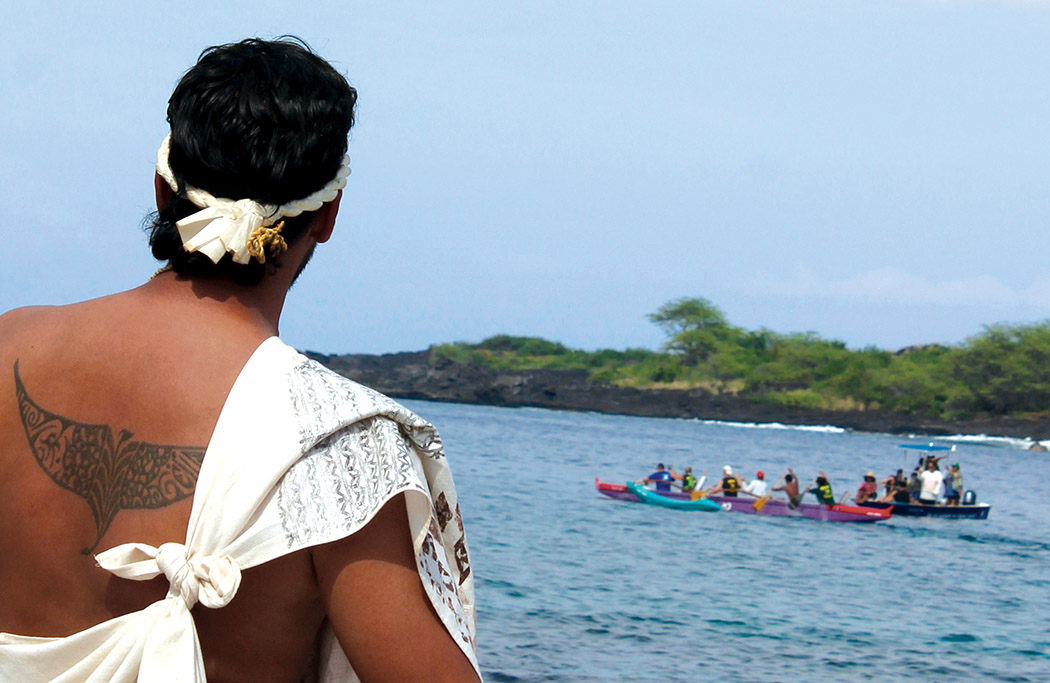
Rippling Outward
On the individual and collective level, the run inspires a greater commitment to respecting the health of one’s body and the well-being of the Earth. During the run, Lanakila asks participants to observe ‘ai pono, or healthy eating, by eating locally-sourced food and avoiding refined sugar. Lanakila knows of farmers and gardeners who plant crops specifically to supply the runners.
Some of Lanakila’s Japanese students were so enthused by experiencing the prayer runs in both Hawai‘i and California that they started a four-day ceremonial run around Mt. Fuji in 2017, an event that Hawai‘i delegates attend every year. Stopping at important shrines and temples along the route, the Tasuki runners carry a Shinto staff adorned with bells and multi-colored ribbons that represent all the peoples of the world.
Lanakila credits the Aha Pule ‘Āina Holo with inspiring him to “put my body where my prayers were at.” In March 2015 he literally ran up Maunakea to prevent construction crews from accessing the mountain. When he put a call out on Facebook for help, the first people to come up the mountain to support him were not big-name activists or cultural practitioners, but a mother and daughter who had participated in the ceremonial run four months before.
Back in Waimea, Pua Case is looking forward to this year’s Aha Pule ‘Āina Holo, which will take place November 6–11. Reflecting on the run’s many interwoven layers, she observes that people are drawn to the ceremony and culturally based values that it embodies. “It’s amazing to me to watch a runner and cheer them on,” Pua says. “Every step of the way is filled with prayer, respect, and protocol starting from Maunakea all the way to where it ends in Honoka‘a.” ❖
Photos courtesy of Aha Pule ‘Āina Holo Participants
For more information:
info.hccoh@gmail.com or facebook.com/puleainaholo/
References
Cunningham, Scott. Guide to Hawaiian Magic and Spirituality. Woodbury, MN: Lewellyn Publications, 2009, p 24-25.
Malo, David. Hawaiian Antiquities. Honolulu, HI: Bishop Museum Press, 1997, p 146.
Mann, Marya. “Makahiki—Codes for Regeneration.” Ke Ola Magazine, Nov/Dec 2012.
Scheurell, Diane. “On foot around the Big Island in four days—Aha Pule ‘Aina Holo.” Manifesting Paradise Blog, Dec. 9, 2014.
